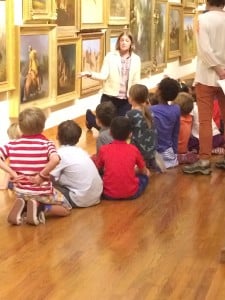 Welcome Educators!
Welcome Educators!
The American Museum of Western Art—The Anschutz Collection invites schools and educational organizations to join us for FREE on-site tours and activities.
Can’t make a field trip? Bring the Old West to your classroom with our historic timeline or use our Lessons and Activity Ideas. These free teacher resources contain historic background information and step-by-step instructions that are adaptable for all grade levels, Pre-K – 12th, and address a wide array of Colorado state standards in Visual Arts, Social Studies, Reading, Writing and Communication, and Science. We encourage educators to use these free teacher resources available on our education website found at http://Education.AnschutzCollection.org.
[su_accordion]
[su_spoiler title=”What and Where is the American West?” style=”fancy” open=”yes”]At the beginning of the 19th century, lands west of the Mississippi, East of the Pacific Ocean, and North of the Rio Grande went through major political, environmental, and demographic changes in less than 100 years. In 1800 the bulk of this territory, the traditional home of many Native American tribes, were politically controlled by either France or Spain.
Beginning with the Louisiana Purchase of 1803, the United States began a process of territorial expansion through wars and treaties, encouraging its citizens to settle in the newly acquired territories. Eventually, by the early 20th Century, the political borders of the United States extended from the Atlantic to Pacific oceans in the organization that is familiar to us.[/su_spoiler]
[su_spoiler title=”What is Western American Art?” style=”fancy”]Artists have been creating artwork in the western region of the North American continent for centuries. However, “Western American Art” refers to the art whose subject matter refers to this region and was produced by artists who came from a Euro-American stylistic and cultural heritage.[/su_spoiler]
[su_spoiler title=”Historic Timeline” style=”fancy”]To view Western American paintings in the Museum’s collection in context with major historical, political, and social events, check out our Historic Timeline.[/su_spoiler]
[su_spoiler title=”Lesson and Activity Ideas” style=”fancy”]The American Museum of Western Art—The Anschutz Collection displays over 300 paintings that survey 200 years of westward expansion. To make the breadth of our collection more digestible in a classroom environment, we’ve broken it down into three categories:
- People: The people that inhabited and settled the American Frontier were a diverse mix of cultures and professions. Their experiences together, good and bad, shaped the character of the region
- Places: The people that inhabit the Western United States have a special relationship with the natural world around them. The land is imposing and awe-inspiring, the flora and fauna diverse and unique. People here learned to live within the bounds of the natural world, and attempted to master it. Artists took inspiration from what they experienced, and used the environment to create myths, metaphors, and a modern aesthetic.
- Stories: Artists interpreted events or used Western subjects to create visual narratives. Utilizing several artistic techniques and styles, they expressed the drama, action, and emotion of the real or imagined stories of the West.
[/su_spoiler]
[/su_accordion]

